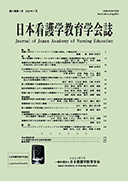
- |<
- <
- 1
- >
- >|
-
Shinobu Saito, Mariko Tobise, Yoshiko Wazumi, Fusako KawabeArticle type: Original Article
2022 Volume 32 Issue 3-1 Pages 1-13
Published: 2022
Released on J-STAGE: December 26, 2022
JOURNAL FREE ACCESS〔Objectives〕The objective of the present study was to identify the recognition and expression characteristics of novice nurses that emerged when nursing processes were implemented towards simulated patients for the first time, and to examine the formation of recognition as a nursing professional.
〔Methods〕A qualitative inductive analysis of recognition and expression characteristics for each type of nursing experience was conducted using assignment reports submitted by first-year nursing students at University A after conducting an exercise using simulated patients for the first time.
〔Results〕Among the 55 students that gave consent to participate in the study, we identified eight characteristics of recognition and expression during the formation of realistic images of patients as nursing professionals. One example is that, when interacting with a simulated patient as a nurse for the first time, novice nurses become interested in the words and gestures of their patients to recognize whether or not their words and actions would be accepted as those of a nurse.
〔Conclusions〕Novice nurses wore two hats, one of a nurse and one of a student. It was suggested that novice nurses accumulated real images of patients as reality and formed professional recognition as nurses.
View full abstractDownload PDF (793K) -
Yuko Takahashi, Yasuhiro Matsuda, Nobuko Yamashita, Mika HattoriArticle type: Original Article
2022 Volume 32 Issue 3-1 Pages 15-27
Published: 2022
Released on J-STAGE: December 26, 2022
JOURNAL FREE ACCESS〔Aims〕This study aimed to clarify activities what activities are perceived as difficult by nursing faculty when they are designing nursing lectures.
〔Methods〕Participants included 484 nursing faculty members with lecture experience who were working at basic nursing education institutions Japan. The data was collected through anonymous individual responses to a questionnaire. The respondents’ answers were analyzed using a content analysis employed in nursing education with reference to the technique developed by Berelson.
〔Results〕A total of 181 completed questionnaires were returned (37.4% response rate), of which 178 were valid. The analyses of the valid questionnaires revealed 37 activity categories that were considered difficult by nursing faculty when they were designing nursing lectures to be given in classes. These categories included “selecting the content to be taught from among many contents.” “develop explanations to promote students’ understanding.”
〔Conclusions〕It was suggested that faculty members may have difficulty due to eight causes, such as lack of understanding of the activity contents required for instructional design. The results of this research can be used by faculty members to objectively understand activities that they find difficult and to take measures to overcome the difficulties.
View full abstractDownload PDF (425K)
-
Etsuko Naomasa, Kazuyo KusakaArticle type: Research Reports
2022 Volume 32 Issue 3-1 Pages 29-38
Published: 2022
Released on J-STAGE: December 26, 2022
JOURNAL FREE ACCESS〔Aim〕This study aims to clarify the effectiveness of the emotional intelligence quotient educational program, which is designed to develop the interpersonal relationship skills of nursing students.
〔Methods〕The study was carried out on first-year student nurses, who were divided into an intervention group that took the program and a control group that did not. An emotional intelligence scale and a social anxiety by situation scale were used to assess the effectiveness of the educational program.
〔Results〕Data was acquired from a total of 90 students: 45 in the intervention group, and 45 in the control group. Following attendance of the educational program, the intervention group demonstrated significantly higher results in all three domains of the emotional intelligence scale - self - management, relationship management, and social awareness than the control group. The intervention group also demonstrated a significant reduction in anxiety about presenting or speaking in front of an audience on the social anxiety by situation scale following the educational program.
〔Conclusion〕The study’s results suggest that Emotional Intelligence Quotient educational program increases student nurses’ emotional intelligence, reduces their social anxiety, and improves their interpersonal relationship skills.
View full abstractDownload PDF (386K) -
Nao Saito, Aiko Abe, Michiko Shoji, Takeshi Matsunaga, Aki Sugawara, M ...Article type: Research Reports
2022 Volume 32 Issue 3-1 Pages 39-53
Published: 2022
Released on J-STAGE: December 26, 2022
JOURNAL FREE ACCESS〔Aim〕We clarify the effectiveness and tasks by nursing students and faculties in introducing a rubric into the 2019 adult nursing practicum.
〔Methods〕We analyzed the difference in the evaluation of achievement of practical goal between the students and faculties, and their actual use and perceptions of rubric by focus group interviews for students and faculties.
〔Results〕The evaluation of achievement by 87students and 7 faculties, matched in 11 of the 15 evaluation viewpoint items. The rubric was a tool that enables appropriate evaluation of achievement with common criteria among faculty members and students- faculties by clarifying specific evaluation criteria. The rubric was useful as a guide for faculties to give appropriate feedback and for students to autonomously develop practical training to achieve their goals. On the other hand, it is difficult to evaluate easily and in a short time, and there are still tasks in how to effectively utilize each student and faculty, and how to score consistently and objectively.
〔Conclusions〕It was suggested that it is necessary to improve the objective and reliable scoring method and to consider effective utilization methods.
View full abstractDownload PDF (523K)
-
Kaori Kono, Tomoyo Itakura, Chiho Iizuka, Ryo Kayashima, Kyoko Endo, K ...Article type: Activity Reports
2022 Volume 32 Issue 3-1 Pages 55-64
Published: 2022
Released on J-STAGE: December 26, 2022
JOURNAL FREE ACCESSDownload PDF (434K)
- |<
- <
- 1
- >
- >|